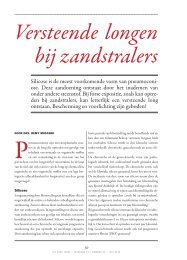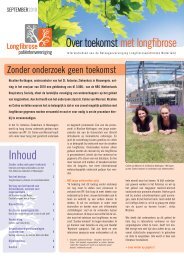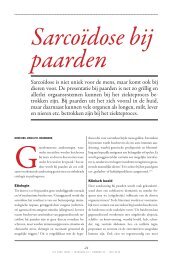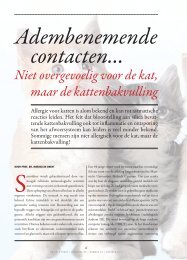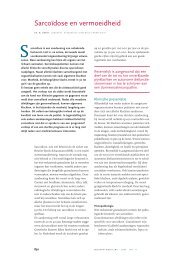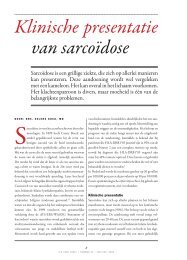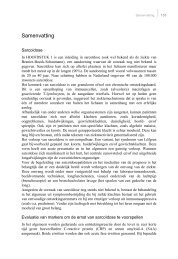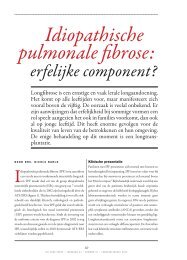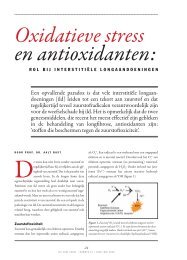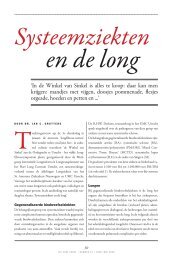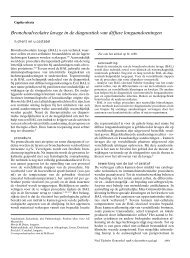Interpretation of bronchoalveolar lavage fluid cytology - ILD care
Interpretation of bronchoalveolar lavage fluid cytology - ILD care
Interpretation of bronchoalveolar lavage fluid cytology - ILD care
Create successful ePaper yourself
Turn your PDF publications into a flip-book with our unique Google optimized e-Paper software.
<strong>Interpretation</strong> <strong>of</strong> BALF <strong>cytology</strong><br />
Diagnostic applications <strong>of</strong> BALF analysis in patients with diffuse lung disease<br />
The diagnostic evaluation <strong>of</strong> patients with D<strong>ILD</strong> is a clinical challenge. Thorough clinical assessment should be<br />
considered as the key diagnostic procedure as a specific diagnosis, even with lung biopsy, is dependent on clinical<br />
information. To establish or confirm the diagnosis in patients with D<strong>ILD</strong> many ancillary noninvasive procedures are<br />
required [1]. Although histologically confirmation is preferable and tissue specimen are sometimes mandatory for<br />
a definitive diagnosis, BALF analysis <strong>of</strong>fers the opportunity to establish the diagnosis in selected cases. If analysis<br />
<strong>of</strong> BALF is diagnostic or highly suggestive <strong>of</strong> the underlying disease process with only a low risk <strong>of</strong> a false diagnosis,<br />
it obviates more invasive procedures such as biopsy procedures [1, 2, 9, 14]. In the appropriate clinical setting, the<br />
diagnosis <strong>of</strong> alveolar proteinosis, pulmonary histocytosis X, extrinsic allergic alveolitis or hypersensitivity pneumonitis<br />
and drug-induced pneumonitis, eosinophilic pneumonia, pulmonary haemosiderosis, sarcoidosis and infections may<br />
be established with appropriate analysis <strong>of</strong> BALF [8, 25]. Together with a thorough clinical evaluation BALF analysis<br />
may be the key to diagnosis making lung biopsy unnecessary in most cases. However, if despite this thorough<br />
clinical evaluation the diagnosis remains unclear, a biopsy should be considered as the final diagnostic step [1, 2].<br />
Prospective studies are needed to address the cost effectiveness <strong>of</strong> clinical assessment, routine high resolution<br />
computed tomography (HRCT), BAL, transbronchial biopsy, surgical lung biopsy (open versus thoracoscopic) as<br />
diagnostic procedures and their effect on the clinical outcome [1].<br />
Cellular BALF characteristics as valuable adjunct to diagnosis<br />
Table 2. – Normal values <strong>of</strong> the cellular <strong>bronchoalveolar</strong> <strong>lavage</strong> pr<strong>of</strong>ile<br />
Nonsmokers Smokers<br />
Yield<br />
mL 138±89(110-170) 128±15(100-150)<br />
percentage<br />
Total cell count<br />
59.3±3.4(55-85) 57.8±2.3(50-75)<br />
cells x10 4 .mL -1<br />
Alveolar macrophages<br />
10.3±1.6(10.1-18.2) 33.2±3.9(25-60)<br />
cells x10 4 .mL -1<br />
9.3±1.4(9.0-10.5) 27.9±3.2(25-42)<br />
percentage<br />
Lymphocytes<br />
89.8± 0.7(83-95) 94.5± 0.6(90-95)<br />
cells x10 4 .mL -1<br />
0.8±0.1(0.7-1.5) 0.8±0.3(0.6-1.5)<br />
percentage<br />
Polymorphonuclear neutrophils<br />
8.4±0.7(7.5-12.5) 3.8 ±0.5 (2.5-12.5)<br />
cells x10 4 .mL -1<br />
0.10±0.03(0.05-0.25) 0.31±0.90(0.25-0.95)<br />
percentage<br />
Eosinophils<br />
1.3±0.2(1.0-2.0) 1.2±0.2(1.0-2.5)<br />
cells x10 4 .mL -1<br />
0.03±0.05(0.02-0.08) 0.14±0.03(0.10-0.35)<br />
percentage<br />
Mast Cells<br />
0.44±0.11(0.21-0.52) 0.43±0.08(0.30-0.80)<br />
cells x10 4 .mL -1<br />
0.01±0.01(0.01-0.02) 0.16±0.06(0.02-0.09)<br />
percentage 0.09±0.03(0.10-0.35) 0.43±0.08(0.02-1.01)<br />
CD4 + /CD8 + -ratio 2.6±0.2(2.2-2.8) 1.5±0.1(0.7-1.8)<br />
Data are expressed as mean values±SEM with range in parentheses.<br />
Normally, BALF samples, obtained from healthy nonsmoking controls, contain 80-90% alveolar macrophages (AMs),<br />
5-15% lymphocytes, 1-3% polymorphonuclear neutrophils (PMNs),



